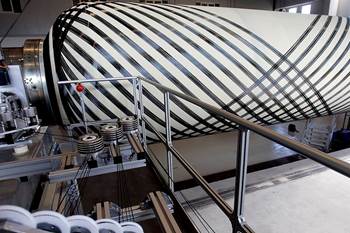Search Results
Showing 281 – 290 of 2585 results
High-pressure gas storage vessels represent one of the largest and fastest-growing markets for advanced composites, particularly for filament-wound carbon fiber composites. Although they are used in self-contained breathing apparatuses and provide oxygen and gas storage on aerospace vehicles, the primary end markets are for storage of liquid propane gas (LPG), compressed natural gas (CNG), renewable natural gas (RNG) and hydrogen gas (H2).
Filament winding is a specialized technique used in composite manufacturing, involving the precise and automated winding of continuous fibers onto a rotating mandrel or mold. This method allows for the creation of strong and seamless structures, optimizing the alignment and orientation of the fibers to meet specific design requirements. Filament winding is employed in producing cylindrical or conical composite parts, such as pipes, pressure vessels, and aerospace components, enabling engineers to tailor the strength, stiffness, and performance characteristics of the final product.
Processes in composites manufacturing encompass a diverse array of techniques employed to fabricate composite materials. These processes include methods like hand layup, where layers of resin and reinforcement materials are manually placed, and vacuum infusion, where a vacuum draws resin into a preform. Other techniques like compression molding, filament winding, and automated methods such as 3D printing are utilized to create intricate and specialized composite structures. Each process offers unique advantages in terms of precision, scalability, and efficiency, catering to diverse industry needs. As technology advances, newer methods are emerging, promising faster production cycles, reduced waste, and increased customization, driving the evolution of composite manufacturing towards more sophisticated and versatile methodologies.
The wind energy market has long been considered the world’s largest market, by volume, for glass fiber-reinforced polymer (GFRP) composites — and increasingly, carbon fiber composites — as larger turbines and longer wind blades are developed, requiring higher performance, lighter weight materials. The outer skins of wind and tidal turbine blades generally comprise infused, GFRP laminates sandwiching foam core. Inside the blade, rib-like shear webs bonded to spar caps reinforce the structure. Spar caps are often made from GFRP or, as blade lengths lengthen, pultruded carbon fiber for additional strength.
Leesona showcases high-quality, precision, automatic and manual winding solutions that are capable of working with a range of composite materials and fiber thicknesses.
The university is developing a large-scale glass fiber composite recycling system as an end-of-life (EoL) solution for wind blades.
Onshore and offshore operational wind farms’ interactions with a range of environmental factors often lead to blade damage. ArmourEDGE improves wind blade aerodynamics, durability and reduces downtime.
The company’s proprietary UHMWPE fabrics combined with technical films in a patented fusion process are said to increase performance and recyclability.
Taiwan-based Swancor will supply resins and composite materials for MHI Vestas’ offshore wind projects in Taiwan.
With the involvement of two schools from the Institut Mines-Télécom, the 4-year project aims to improve the intrinsic properties of a composite material based on Elium via four concrete demonstrators.
State of Maine seeks nation’s first floating offshore wind research array, located in the Gulf of Maine, to advance new technology in collaboration with Maine’s fishing industry.
Vestas is supplying and supervising installation of 13 wind turbines made of composites, with the third quarter of 2021 the expected completion date.
Reported to be the world’s largest offshore hybrid drive wind turbine with a 242-meter diameter rotor, 118-meter-long blades and 46,000-square-meter swept area, the MySE 16.0-242 enhances energy production, CO2 elimination and efficiency capabilities.
As the wind energy market continues to grow, competition heats up between glass and carbon fiber composites for turbine blades.









